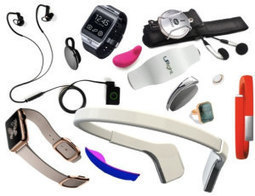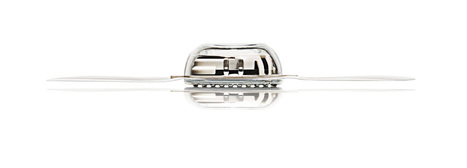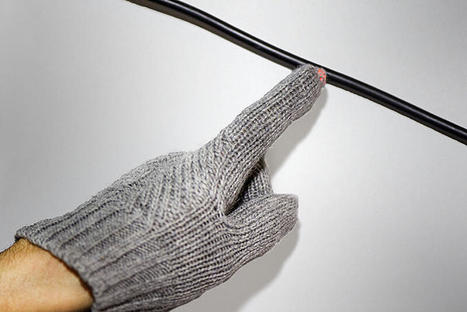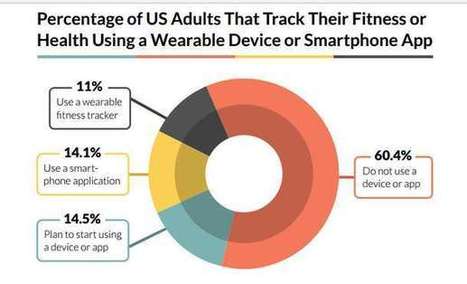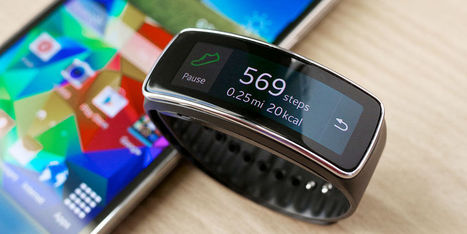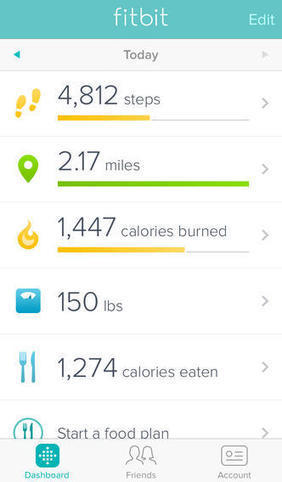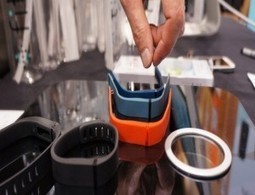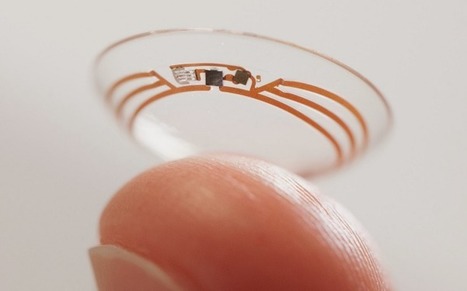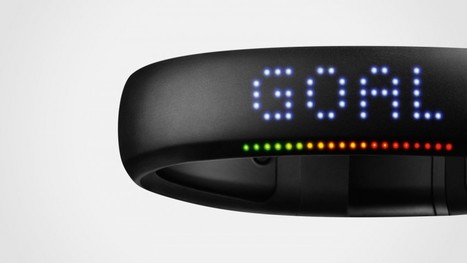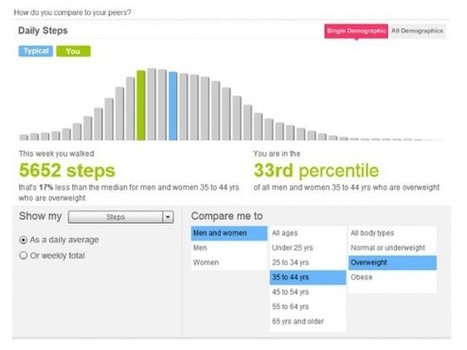 Your new post is loading...
 Your new post is loading...

|
Scooped by
nrip
|
Silicone wristbands are just as good as traditional testing methods at detecting chemicals in the air that can be harmful during pregnancy. Inexpensive, convenient silicone wristbands can measure exposure to a class of chemicals that can be harmful during pregnancy, researchers report. The researchers found that the wristbands, when used as passive samplers, have the ability to bind smaller molecular weight semi-volatile polycyclic aromatic hydrocarbons (PAHs) in a similar pattern as active sampling. PAHs are a class of chemicals that occur naturally in coal, crude oil, and gasoline and are produced when coal, oil, gas, wood, garbage, and tobacco are burned. The use of wristbands is appealing because it is inexpensive and easy to wear,” access the study at https://doi.org/10.1038/s41370-021-00348-y read the original unedited article at https://www.futurity.org/silicone-wristbands-polycyclic-aromatic-hydrocarbons-chemicals-pregnancy-2602202/

|
Scooped by
nrip
|
Wearables that have weaved their way into everyday life include smart watches and wireless earphones, while in the healthcare setting, common devices include wearable injectors, electrocardiogram (ECG) monitoring patches, listening aids, and more. A major pain point facing the use of these wearables is the issue of keeping these devices properly and conveniently powered. As the number of wearables one uses increases, the need to charge multiple batteries rises in tandem, consuming huge amounts of electricity. A research team, led by Associate Professor Jerald Yoo from the Department of Electrical and Computer Engineering and the N.1 Institute for Health at the National University of Singapore (NUS), has developed a technology that enables a single device, such as a mobile phone placed in the pocket, to wirelessly power other wearable devices on a user's body, using the human body as a medium for power transmission. The team's novel system has an added advantage—it can harvest unused energy from electronics in a typical home or office environment to power the wearables. The NUS team designed a receiver and transmitter system that uses the human body as a medium for power transmission and energy harvesting. Each receiver and transmitter contains a chip that is used as a springboard to extend coverage over the entire body. A user just needs to place the transmitter on a single power source, such as the smart watch on a user's wrist, while multiple receivers can be placed anywhere on the person's body. The system then harnesses energy from the source to power multiple wearables on the user's body via a process termed as body-coupled power transmission. In this way, the user will only need to charge one device, and the rest of the gadgets that are worn can simultaneously be powered up from that single source. The team's experiments showed that their system allows a single power source that is fully charged to power up to 10 wearable devices on the body, for a duration of over 10 hours. As a complementary source of power, the NUS team also looked into harvesting energy from the environment. Their research found that typical office and home environments have parasitic electromagnetic (EM) waves that people are exposed to all the time, for instance, from a running laptop. The team's novel receiver scavenges the EM waves from the ambient environment, and through a process referred to as body-coupled powering, the human body is able to harvest this energy to power the wearable devices, regardless of their locations around the body. This paves the way for smaller, battery-free wearables read the paper in Nature at http://dx.doi.org/10.1038/s41928-021-00592-y read the original unedited article https://techxplore.com/news/2021-06-approach-wirelessly-power-wearable-devices.html

|
Scooped by
nrip
|
With the wearables and health apps markets booming, where do doctors stand in terms of actually making use of the information?
So you are being proactive about your health by purchasing wearable devices and apps, but how helpful is it really if your doctor isn’t up to speed with the technology or able to interpret the data?
Dr. Paul Abramson, a primary care doctor in San Francisco told NPR that as much as these new devices are promoting good health generally, it’s not necessarily practical for doctors to interpret all of the data. “Going through it and trying to analyze and extract meaning from it was not really feasible,” he says. “I get information from watching people’s body language, tics and tone of voice. Subtleties you just can’t get from a Fitbit or some kind of health app.” Part of the issue is that FitBits and Apple Watches aren’t regulated by the FDA – they are considered “low-risk devices” and don’t require approval because they aren’t used for diagnosis or treatment. For that reason, it’s challenging for doctors to treat the data like valid information.

|
Scooped by
nrip
|
As tech giants like Apple, Google and Samsung compete over dominance in the healthcare market, with their latest platforms and apps, the question remains will any or all of these innovations truly tap into the greater realm of consumer health? Aside from the buzz now emanating from consumers’ pockets, is there a real signal being sent out here about how to change healthcare, or will these latest consumer-concentric technologies add nothing more than noise?
Welltok's Scott Rotermund explains that what we really need from Google Fit and HealthKit is an integrated approach that not only collects data, but also meshes with the current healthcare ecosystem.
What lessons learned from the disappointments associated with the consumer use of FitBit and others tell us about behavior change? We’ve learned two things:
1. A cool gadget is not enough – The novelty will wear off along with the use of the wearable. In my experience, most people lose interest in their tracking device after a month – they learn their sleep patterns, know average steps, etc. To maintain usage, we’ve tied tracking devices to challenges, participatory incentives and personalized action plans with defined goals.
2. Relying on the consumers to take action – With the startling statistics associated to preventable diseases like obesity and diabetes, it’s safe to say that we cannot expect consumers to take action on their own. These big tech giants are treating health activities as they would consumer electronics – the same rules don’t apply. To move beyond early adopters, they need to tie into programs that provide personalized guidance on how to use the trackers and the resulting data, and align those defined actions with the right incentives to get people moving.
more at http://hitconsultant.net/2014/07/22/is-integration-the-key-to-google-fit-and-healthkits-success/

|
Scooped by
nrip
|
Wearables, devices used to sense data and process it into information, are generating quite the buzz in healthcare these days. But down the line, does that buzz come with a sting?
In Wearable Tech News, Tony Rizzo reports wearable technology spending predictions of $50 billion by 2018. He also reports on a ground-breaking, glucose-sensing contact lens for diabetics that will be a “true solution for a very real medical problem that affects hundreds of millions of people.”
By 2016, wearable wireless medical device sales will reach more than 100 million devices, according to a Cisco blog on the future of mobility in healthcare. The importance of these devices is that healthcare professionals can access critical data via mobile apps before, during and after a patient’s hospitalization, thus boosting the speed and accuracy of patient care, the blog says.
The Age of Wearables has a few caveats, though – note that a doctor “can,” “could,” “may” or “potentially” be able to monitor a patient from a wearable, as the products are still under development. One product cites unpublished research as support, and another uses a modality, thermography, that the National Cancer Institute states has no additional benefit for breast cancer screening.
The new, intense focus on wearables is the engagement of the general public, both the ill and the well, and how they collect and transmit patient information to physicians and EHRs. This presents two challenges:
1. Are physicians prepared for this tidal wave of data and information? 2. What is the true cost of the data surge versus its benefits?
Like all healthcare information technology, wearables have huge potential – married to massive challenges.

|
Scooped by
nrip
|
So far the internet of things hasn’t made much headway into patient care in the medical setting, but consumers are buying wellness devices for a variety of reasons. Will the medical world embrace that data?
The intersection of healthcare and connected devices was thrown into high relief these last few weeks as both Apple and Samsung unveiled ecosystems to take consumer health data and turn it into actionable intelligence.
But this week’s guests at the Weekly podacst at GigaOm are confident that as advanced as consumer-grade consumer grade health devices get, they won’t become something doctors are hot on for years to come — if ever.
In this week’s podcast Stacey Higginbotham discusses medical connected devices and where it may meet the consumer with Rick Valencia from Qualcomm Life. Will doctor’s prescribe our apps or devices?

|
Scooped by
nrip
|
A newly published Apple patent application that details ways to improve a wrist-based pedometer could represent another piece of evidence pointing to an iWatch.
The application, “Wrist Pedometer Step Detection,” came out of the U.S. Patent and Trademark Office today. This is part of the standard patent process toward issuance. It details ways to improve step detection when someone is wearing a pedometer on a wrist.
In the patent application’s implementation, the pedometer might be able to “automatically determine that the pedometer is being worn on a user’s wrist.”
Pedometers, the application points out, are often attached to a user’s trunk – on the waist or pants or shirt pocket. A commonly used algorithm to measures steps, however, doesn’t work as well when the pedometer is on a wrist, because the arm’s movement can interfere with the measurement of acceleration.
Apple’s patent application would overcome this by filtering the measured movement or inferring steps from previous measurements, leading to more accurate step counts and distance estimation. Additionally, the document notes, “users do not have to specify where the pedometer is being worn” because the software will compensate.

|
Scooped by
nrip
|
Wearables may be the tech du jour, but the next generation of devices and services needs to focus more on keeping users engaged in the long-term. These three factors, based on behavioral science, can help them do just that.
1. Habit formation. Sustained engagement depends on a device or service’s ability to help the user form and stick with new habits. Wearable devices have the potential, all too often unrealized, to make the process of habit formation more effective and efficient than ever before. The best engagement strategies for wearables move beyond just presenting data (steps, calories, stairs) and directly address the elements of the habit loop (cue, routine, reward), triggering the deep-seated psychological sequences that lead to the establishment of new habits.
2. Social motivation. To sustain engagement beyond the initial habit formation, a device or service must be able to motivate users effectively. Social connections are a particularly powerful source of motivation that can be leveraged in many creative ways. In addition to using social connections to influence behavior, social media and networking sites can be exploited to alter habits for positive outcomes.
3. Goal reinforcement. To achieve sustained engagement, a user also needs to experience a feeling of progress toward defined goals. Research shows that achieving several smaller goals provides the positive momentum necessary for achieving bigger goals. Wearable products and services that help people experience continuous progress can do so, for example, through real-time updates that are powered by big data and insights. Facilitating personal progress in this way leads to improved health, user satisfaction and long-term sustained engagement.
more at http://gigaom.com/2014/02/22/the-three-critical-factors-wearable-devices-need-to-succeed/

|
Scooped by
nrip
|
Women facing imminent danger when walking down the street or getting into their cars will soon have new safety options in the booming wearables space.
Sense6, a five-member startup based in San Francisco, is unveiling jewelry pieces that sync to a user’s cellphone to alert authorities when the wearer encounters danger.
The device, which syncs via Bluetooth, simultaneously sends geolocation alerts to the phones of family members and loved ones at the touch of a button. Sense6′s smart jewelry also contains voice recorders that activate automatically and send the data in real time to the cloud.
more at http://venturebeat.com/2014/02/16/smart-jewelry-could-save-womens-lives/

|
Scooped by
nrip
|
A high-tech bra with a built-in heart rate sensor will only release upon detecting some serious love vibes.
Japanese lingerie company Ravijour doesn't want its customers to settle for anything less than true love. That's why it developed the True Love Tester, a bra with a mission to keep its contents contained until the wearer is really head over heels. Ravijour calls it "a revolutionary bra that knows how women truly feel." A promotional video implies the brassiere could help save women from one-night stands with less-than-savory men.
The bra contains a heart-rate sensor and sends the data it collects, via Bluetooth, to an app for analysis. The app calculates what the designers call the "true love rate," comparing the readings to activities like shopping, watching a horror movie, flirting, jogging, or receiving a surprise gift.

|
Scooped by
nrip
|

|
Scooped by
nrip
|
New research indicates a wireless device could do a better job than the Holter monitor, the standard of care for mobile heart rhythm monitoring over the past half-century.
The Scripps Translational Science Institute compared the Holter monitor with the ZIO Patch, an FDA-cleared, non-invasive, water-resistant device worn on the chest for up to two weeks. STSI, based in San Diego, compared electrocardiograph data from 146 Scripps Green Hospital ambulatory care patients who were fitted with both the ZIO Patch and a Holter monitor.
In all, researchers said, the ZIO Patch, developed by San Francisco-based iRhythm, identified 96 arrhythmia events, while the Holter monitor detected 61.
“This is the first large prospective validation that this new technology superseded the device invented by Norman Holter in 1949,” said Eric Topol, MD, chief academic officer at Scripps Health and STSI's director.
Topol, a cardiologist and lead author of the study, continued in a prepared statement that over the course of tracking every heartbeat for two weeks “the ZIO Service proved to be significantly more sensitive” than the Holter, which consists of a cellphone-sized recorder usually worn about the waist and five to seven lead wires attached to the chest and can only be worn for 24 hours at a time.
“For millions of people who present each year with suspected arrhythmia, this may prove to be the new standard for capturing the culprit heart rhythm electrical disturbance, most commonly atrial fibrillation which carries a significant risk of stroke,” Topol added.
|

|
Scooped by
nrip
|
Purdue University engineers have developed a method to transform existing cloth items into battery-free wearables resistant to laundry. These smart clothes are powered wirelessly through a flexible, silk-based coil sewn on the textile. In the near future, all your clothes will become smart. These smart clothes will outperform conventional passive garments, thanks to their miniaturized electronic circuits and sensors, which will allow you to seamlessly communicate with your phone, computer, car and other machines. This smart clothing will not only make you more productive but also check on your health status and even call for help if you suffer an accident. The reason why this smart clothing is not all over your closet yet is that the fabrication of this smart clothing is quite challenging, as clothes need to be periodically washed and electronics despise water. Purdue engineers have developed a new spray/sewing method to transform any conventional cloth items into battery-free wearables that can be cleaned in the washing machine. "By spray-coating smart clothes with highly hydrophobic molecules, we are able to render them repellent to water, oil and mud," said Ramses Martinez, an assistant professor in Purdue's School of Industrial Engineering and in the Weldon School of Biomedical Engineering in Purdue's College of Engineering. "These smart clothes are almost impossible to stain and can be used underwater and washed in conventional washing machines without damaging the electronic components sewn on their surface." read the study at http://dx.doi.org/10.1016/j.nanoen.2021.106155 read the original and unedited version of the article at https://phys.org/news/2021-06-wearables-future-washable-smart-powered.html

|
Scooped by
nrip
|
Everyone loves the idea of strapping a smartwatch to their wrist and using it to get a bit healthier, but there's a fine line between casual wearables and serious medical devices. It's an important distinction, since while the former can be sold without any sort of oversight, the latter is rightly covered by the FDA's regulations. Since the most recent batch of fitness wearables could be blurring the borders somewhat, the agency has decided to make its thinking on the subject a little clearer.
The agency has published a draft guidance note that, as yet, isn't legally binding and requests opinions from the public. As far as it's concerned, "general wellness devices," i.e. watches that vaguely encourage people to get fitter, aren't any sort of risk to the public. This means that your Fitbit is okay to tell you to go for a walk, your Aura can coach your sleeping and Lumosity can pretend to make you smarter without any worries. Mostly the FDA is concerned with risk, and there isn't much risk if your smartphone tells you to lay off the burgers one every now and again.
more at http://www.engadget.com/2015/01/20/fda-wearables-guidance-note/

|
Scooped by
nrip
|
Late last month, TechnologyAdvice released an interesting study looking at whether most people want to use health wearables such as fitness trackers and other tools for health purposes.
Here are the top-line results of this study:
- 75 percent of U.S. adults do not track their weight, diet, or exercise using a health tracking apps or devices
- 43.7 percent had no specific reason for not tracking their fitness
- 27.2 percent won’t use these devices due to lack of interest - 25.1 percent of adults are currently using either a fitness tracker or a smartphone app to monitor their health, weight, or exercise.
This sounds like pretty bad news for those who believe the era of health wearables is here. But, this study also raises another question: Are health wearables evangelists fools?
Fard Johnmar, Founder of Enspektos explains why relevancy is the key to boosting the adoption of health wearables.
Read more at http://hitconsultant.net/2014/10/08/are-health-wearables-evangelists-fools/

|
Scooped by
nrip
|
Wearable technologies are set to transform health and wellness experiences and massively increase our expectations of health and wellness services.
This customer shift will transform the health and wellness industry as a whole, dragging regulation and governance kicking and screaming into the 21st century.
Because there’s nothing quite like a vast, shouting mob (of wealthy voters) to drive change.
But first, a little background. The smartphone IS the killer wearable Most of us have a smartphone. Comscore reports 69% of US citizens and 62% of Canadians own one. Every day more of us are connecting them to our daily activities, homes, cars and communities. The expanding universe of “wearable” sensors and peripherals are often simply data inputs for a smartphone-based experience. We expect to see few devices succeed without this symbiotic relationship. Those that try, usually offer an experience that’s inferior to simply pulling out your phone.
The major smartphone manufacturers are heavily invested in developing wearable “ecosystems” around their devices. Through close-range sensing technologies like BLE (iBeacon), NFC and RFID, plus increased availability of mobile web access through Wi-Fi hotspots and cheaper data plans, there’s every reason to expect this trend to continue.
The smartphone already is a wearable. And it’s the hub – a “life tracker” with a growing entourage of sensory peripherals on our bodies, in our homes and all around us. We’ll share our lives in return for transformative wellness experiences A paradigm shift is coming to the world of health and wellness. With the devices on our bodies and in our pockets gathering useful data about our movements, behaviours, preferences and wellbeing, more informed decisions become available.
So what happens next?1. The value we receive from sharing our wellness data will erode our privacy fears.2. Augmented reality will eventually become the new normal for healthcare professionals.3. Personal healthcare innovations will be swiftly subsumed into the major ecosystems. (Apple and Google)4. Healthcare providers need to embed digital capabilities, fast
- See more at: http://blog.thirdscreen.com.au/blog/2014/07/17/4-ways-wearables-will-transform-the-healthcare-experience/#sthash.18sChtZa.QuHsWyMK.dpuf

|
Scooped by
nrip
|
Considering the pace of technological growth in recent decades, the convergence of humans and machines seems a foregone conclusion. Yet, unlike most machines, the body is far too flexible and squishy for modern advanced materials. So it falls on researchers to develop new stretchable technologies that are easily manufactured and relatively inexpensive.
Recently, a biomedical engineering team at Purdue University developed a methodology to generate zigzag patterns out of conventional wire that can extend up to five times in length. The wires can be utilized as conductive interconnects between sensors, allowing for flexible networks or meshes to be embedded or wrapped around 3D objects.
“This compares to only a few percent for an ordinary metal connection,” said Professor Barak Ziaie, leading the research in the press release. “The structures are also highly robust, capable of withstanding thousands of repeated stretch-and-release cycles.”
Even more intriguing, the approach utilizes a standard sewing machine to fabricate the system.
Using water-soluble thread, the technique involves stitching wire in zigzags onto standard transparencies used with overhead projectors.
A commercially available elastomer called Ecoflex is poured over the sheet and allowed to solidify. The thread is dissolved with warm water, allowing the flexible polymer with the embedded wires to be separated from the transparencies.
To demonstrate how their approach could be used for medical devices, the team generated a sensor system that wraps around a urinary catheter balloon - as the balloon inflates, the sensor gauges the strain.
This flexible system can measure much greater expansion than conventional approaches that employ rigid metal films that permit only small percentages of stretching before breaking.
The findings, to be published in a forthcoming paper, were reported at the Solid-State Sensors, Actuators and Microsystems Workshop.
more at http://singularityhub.com/2014/06/10/simple-sewing-machine-has-high-tech-role-in-future-soft-machines/

|
Scooped by
nrip
|
As the number of self-tracking health and fitness tools available to consumers continues to climb, a persistent question has been whether the data they collect might be useful to health researchers. Along with that: Are people who self-track comfortable sharing their data with researchers?
A new, must-read report from San Diego’s California Institute for Telecommunications and Information Technology (Calit2), funded by the Robert Wood Johnson Foundation, explores these and other questions.
Based on a survey with hundreds of self-trackers, a majority — 57 percent — said one critical assurance they would need before agreeing to make their self-tracked, personal health data available to researchers was that their privacy would be protected. More than 90 percent also said it was important that their data remained anonymous. Respondents said they’d be more comfortable sharing data if they knew it was only going to be used for “public good” research.
One open-ended survey that the report’s researchers posed to self-trackers found that 13 percent of respondents specifically mentioned an aversion to commercial or profit-making use of their data, according to the report. One respondent wrote: “It depends who gets it. Research using these data will be instrumental in the future of personal predictive services, but also for that reason are likely to be exploited by marketers and the politically short-sighted. Thus I would like transparency for who has access to my data.”
Among the almost 100 health researchers interviewed for the report, 46 percent said that they had already used self-tracking data in their research previously. Some 23 percent reported that they had already worked with digital health companies that offer apps or devices to consumers to track their health.
Overall, the researchers interviewed for the report were “generally enthusiastic” about the prospect of using self-tracking data in the future — 89 percent agreed or strongly agreed that such data would prove useful to their research efforts. Almost all of those researchers surveyed said that kind of data could answer questions that other data could not.
more at http://mobihealthnews.com/30979/health-researchers-see-unique-opportunity-in-self-tracker-data/

|
Scooped by
nrip
|
Sustained engagement is emerging as the key challenge for companies developing wearable devices and complementary services. What these companies may not be aware of is the importance of habit formation, social motivation, and goal reinforcement. These three factors, drawn from behavioral science, contain the secrets to successful wearable products and related services that get used and deliver real value.
A failure to engage A surprising percentage of devices in the market fail to achieve even short-term engagement for many users because they suffer from one or more fatal user experience flaws. Product design teams typically work toward nine baseline criteria that must be met to drive initial adoption and use: selectability, design, out-of-box experience, fit/comfort, quality, user experience, integration ability, lifestyle compatibility, and overall utility. Many current devices fail on one or more of these criteria by breaking, failing after a shower, pulling the hairs off your arm, running down quickly, or being a pain to sync with your smartphone. Sadly, the growing number value-added services designed to exploit the data these wearables provide and their open APIs also suffer from similar problems with user experience. Beyond traditional design criteria However, even if these criteria are satisfied, they are not sufficient to drive long-term use. Traditional product design criteria are only part of the key to developing successful wearable products and services. Devices and services that help wearers change their habits also promote sustained behavior change and lead to long-term health. Behavioral science offers three other critical factors that can lead to the development of successful wearable products and related services.
Key factor #1: habit formation Sustained engagement with a wearable device or complementary service depends on its ability to help the user form and stick with new habits. Psychologists define habits as automatic behaviors or routines that are triggered by situational cues, which are then followed by some form of reward. Habits have three key components: cues, routines, and rewards. The best wearable devices have the potential to make the process of habit formation more effective and efficient than ever before.
Key factor #2: social motivation Sustained engagement beyond initial habit formation with a wearable device or complementary service depends on its ability to motivate users effectively. Social connections are a particularly powerful source of motivation that can be leveraged in many creative ways. In addition to using social connections to influence behavior, social media and networking sites can be exploited to alter habits for positive outcomes. This includes the communication of social norms through “postings” or “sharing” of thoughts, pictures, and comments with one another.
Key factor #3: goal reinforcement To achieve sustained engagement, a user needs to build on these habits and social motivation to experience a feeling of progress toward defined goals. Research shows that achieving several smaller goals provides the positive momentum necessary for achieving bigger goals. Wearable products and services that help people experience continuous progress can do so, for example, through real-time updates that are powered by big data and insights. Facilitating personal progress in this way leads to improved health, user satisfaction, and long-term, sustained engagement.
Read more: http://medcitynews.com/2014/03/create-long-term-value-wearables-inspire-behavior-change/#ixzz2utQe7O1q

|
Scooped by
nrip
|
With all of the buzz being created by wearable technology, one company has decided to try to take all of the data and numbers surrounding the market and make sense of them, including compiling a list of every single device currently on sale that can be described as a wearable tech device.
The work is ongoing, but so far, Vandrico Inc, a Canadian research firm specialising in verifying technology, has compiled a list of 115 individual gizmos or gadgets.
At this early stage of what many are predicting with be a tech revolution, the average price of a device is US$431 (RM1,425) and the early market is being driven by health and well-being.
Just under 70 per cent of all wearable tech products (80 devices) on sale or in the advanced prototype stage (such as Google Glass) can be categorised as ‘Lifestyle,’ while ‘Fitness’ accounts for 51 devices and ‘Medical’ 25, though Vandrico is quick to point out that some gadgets can easily overlap categories.
more at http://www.themalaymailonline.com/tech-gadgets/article/quantifying-the-quantified-self-health-devices-leading-the-pack

|
Scooped by
nrip
|
No one has arms long enough to wear all of the activity-tracking wristbands currently on sale or awaiting release. These devices count your steps, measure your sleep and some even monitor your heart rate.
But do you know how this information immediately applies to your lifestyle, or what you should do with it?
The services behind these trackers need to invest in immediacy by providing useful information, ideally in real time, so we can optimize our wealth of data into action.
Everyone wants to be better, but nobody has a baseline for understanding themselves.
what use is the data without knowing in real time what you, individually, can do to change it?
I’d like to know whether I need to slow down. Am I pushing myself too hard?

|
Scooped by
nrip
|
Finger pricks and careful eating are an important part of the daily routine for most people with diabetes. While automated glucose meters are a growing option, they can still create discomfort and other inconveniences.
Google wants to go in a totally different direction with a project announced today:smart contact lenses that can detect glucose levels via the wearer’s tears and alert them when levels dip or rise.
This isn’t the first smart contact lens, and several options already exist for people interested in monitoring glaucoma. But Babak Parviz, who also leads the Google Glass team, is a smart contact pioneer and Google which is a secretive division of Google dedicated to difficult, future-looking projects, has a reputation for ably pursuing projects like this.
The lens works via a small wireless chip and glucose sensor embedded between two pieces of soft material. The current prototype puts out a reading once a second. Google is also interested in integrating an LED light, which could light up to alert the wearer of dangerous glucose levels.
The lab is now looking for parters to help bring the lens to market. It would also like to develop an app that would help wearers read and manage the data the lens takes in.
The lens could help people with diabetes monitor their daily health and recognize dangerous situations.
more at http://gigaom.com/2014/01/16/google-testing-contact-lens-that-can-monitor-glucose-levels/

|
Scooped by
nrip
|
The consumer electronics industry is expanding beyond its traditional borders as consumers start to adopt technologies that make use of ubiquitous computing power, sensors, and wearable product designs. Shawn Dubravac, chief economist of the Consumer Electronics Association, made this observation of the industry at the first press event at the 2014 International CES, the big tech trade show in Las Vegas this week.
Among the trends he sees taking hold are mass customization, thanks to technologies like 3D printing. The 3D printing companies like Maker Bot have their own space at the show now, 7,000 square feet of exhibits, and it’s sold out. He believes about 99,000 3D printers will ship in 2014.
Consumers are also embracing lots of new screens in their lives. As an example, tablets didn’t exist as a big market in 2009. But now, in the U.S., Dubravac said that tablet ownership is expected to exceed 50 percent of households once the numbers from the holiday season are tallied up.
He also said that wearables and the spread of mobile devices are making more new technologies possible. And many of these new devices are autonomous, or able to do smart things on their via robotics or artificial intelligence.
Dubravac said that mobile devices are expected to outnumber computing devices sold to date sometime in 2014 or 2015.

|
Scooped by
nrip
|
2012 brought a new product category to the market and saw many acquisitions from wearable manufacturers looking to get the edge in a hotly contested space but 2013 has undoubtably been the breakout year for wearables and quantified self hitting the mainstream.
Back in June I started studying the space pretty seriously. I made a few observations and ended up co-founding my own health & fitness app that went on to amass 30,000 downloads as we tested the market (visit BodyWise).
Back when we launched BodyWise, there wasn’t much in the way of being able to track beyond your distance, steps or sleep. We brought tracking of a wide variety of health & fitness metrics to the everyday person. Since our launch I could name half a dozen serious competitors playing on our level and another half a dozen wearables that brought our features to their apps and devices.
As we develop BodyWise v2 I wanted to share with you my summary of the state of play for Wearables & the Quantified Self in 2014:
|



 Your new post is loading...
Your new post is loading...





